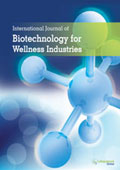ijbwi
Abstract : Response Surface Methodology of Glutamine, Asparagine and 2,4-Dichlorophenoxyacetic Acid for Agave americana L. Embryo Number and their Optimization in a RITA®Automatic Bioreactor System
|
|
Abstract: Response surface methodology was used to investigate the effect of different concentrations of 2,4-dicholorophenoxyacetic acid (2,4-D), asparagine and glutamine on a number of embryos from callus of Agave americana L generated with 0.5mg/L of 2,4-D, treatments obtained according to an experimental design with response surface Box-Behnken with three repetitions at the central point with 0, 1 and 2 mg L-1 2, 4-D; 0, 200 and 500 mg L-1 glutamine and 0, 500 and 1000 mg L-1 asparagine. The embryo number was optimized using the RITA® automatic bioreactors system using a Programmable Logic Controller (PLC) and a Light Dependent Resistor (LDR) varying the immersion frequencies with similar solid and liquid treatments at the same time for comparative purposes. The results showed that interaction between asparagine and glutamine had a statistically significant effect and the largest embryo number was obtained with the higher concentration of the two amino acids, the coefficient of determination (R2) calculated from the validation data for RSM model was 0.92, The use of the RITA® bioreactor had a positive effect on embryo number at 1 min of immersion time and a frequency of 12 times a day comparing with the liquid system but not at others frequencies, possibly because of the physical conditions inside the reactor. Response surface design was an experimental strategy which led to raise the embryo number using asparagine and glutamine as supplement of MS medium in the callus differentiation A. americana L. and using the RITA reactors automatic system was effective to improve the multiplication rate. Keywords: Agave americana L., glutamine, asparagine, somatic embryogenesis, Box-Behnken design, temporal immersion.Download Full Article |
Abstract : Production of Cysteine: Approaches, Challenges and Potential Solution
|
|
Abstract: Cysteine has a wide application in pharmaceutical, foods and cosmetic industries. In the biological system, through its unique properties of sulfur and thiol, cysteine also plays important roles in stability, structure, catalytic activity, and regulation of numerous proteins. In nature, cysteine can be found in animal proteins, fruits, vegetables, legumes and cereal. Due to its wide application, the production of cysteine in large scale is in favour. At present, cysteine is produced from keratin of animal sources as well as through microbial bioconversion and fermentation. Each production method poses its own challenges and limitation; which includes low yield, high-cost and poor consumer acceptance. As such, alternative source for large-scale cysteine production is of interest. Plants are seen to be an attractive substrate for the extraction of cysteine. Keywords: Amino acid biosynthesis, cysteine production, cysteine purification, sulfur amino acid.Download Full Article |
Abstract : Inference about Monophyly of the Family Oedipodidae and the Classification of Subfamilies Based on 16S rDNA Sequences
|
|
Abstract: Most of grasshoppers in the family Oedipodidae are the famous agriculture pests in China. However monophyly and the relationships among the subfamilies within this family are unclear up to now. Here the phylogeny of the Oedipodidae was reconstructed based on 16S rDNA sequence fragments by using Mekongiella kingdoni and Atractomorpha sinensis as outgroups under weighted MP, NJ and Bayesian criteria. The 408 bp fragments of mitochondrial 16S rRNA gene were sequenced for 15 species from 4 subfamilies of the family Oedipodidae, and the homologous sequences of other 15 species of grasshoppers were downloaded from the GenBank data library. The numbers of transitions and transversions among pairwise comparisons of the 16S fragments were respectively plotted against percentage sequence differences. Saturation of transitions was discovered, and transversions were not saturated with the increase of percentage sequence difference in the plots. All the individuals of the Oedipodidae excluding Trilophidia annulata were gathered together in the three trees. Our results are very different from the traditionary taxonomy of the Oedipodidae including 4 subfamilies. The Bryodemellinae is not supported as a subfamily, and neither Locustinae nor Oedipodinae are supported as a monophyletic group in this study. Keywords: Oedipodidae, 16S rDNA, monophyly, subfamily.Download Full Article |
Abstract : The History and Outlook of Animal Drugs Treating Asthma, Chronic Bronchitis, and Haze Episode-induced Respiratory Diseases
|
|
Abstract: Animal drugs have been historically applied in Chinese remedies for more than two thousands. It was reported that Chinese medical animals consisting of 1,590 species took up 12.5% of the total number of all TCM resources. Those animal drugs such as, earthworm, gecko, periostracum cicadae, and scorpios, of commonly used in China, are very remarkable and traditional for the treatment of asthma or chronic bronchitis. This review presents research advance of animal drugs possessing significant implications for the development of novel anti-asthma or chronic bronchitis drugs. The experimental studies and clinical efficacies against asthma and chronic bronchitis of animal drugs were summarized herein. Moreover, the potential utilization of animal drugs on inhibiting haze/fog induced respiratory diseases was also discussed. Keywords: Animal drugs, asthma, chronic bronchitis,medicinal insects, respiratory disease.Download Full Article |























